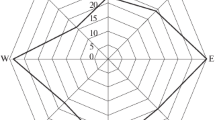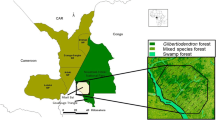Abstract
With data accumulating from a growing pool of chimpanzee field studies, new behaviors as well as novel variants on common behaviors continue to be described. Nest construction is a universal behavior in wild great apes. Among chimpanzee populations, reported variation in nest building behavior mostly reflects environmental constraints. Despite the ubiquity of nest making by chimpanzees, only ground nesting has been recognized as a behavioral variant, potentially determined by both environmental and social factors. In a study of nests made by chimpanzees (Pan troglodytes schweinfurthii) in Bulindi, Uganda, I identified a hitherto undescribed nest construction technique, termed ‘nest tying’. Five observed nests lacked strong weight-bearing structures beneath them, such as large branches or a supporting trunk. Instead, the nests appeared ‘tied’ (or ‘tethered’) to an adjacent trunk by looping leafy stems or palm fronds around it and interweaving these into the nest mattress, securing the nest against the trunk; thus, nest tying presumably functions to provide added stability and support. This preliminary report presents a description of the observed nests. Irrespective of whether nest tying constitutes true knot making—commonly considered absent in wild great apes—this nest construction technique would seem to require advanced dexterity and a sophisticated understanding of the mechanical properties of the plants used. Forest fragments in Bulindi are highly degraded. Thus, nest tying—and construction of integrated nests (i.e., utilizing multiple plants, often small trees and shrubs) generally—may be promoted by a relative paucity of suitable nesting trees at this site. Still, insofar as nest building is learned in chimpanzees, different construction techniques including nest tying are potentially acquired through social learning. Further investigation is required to ascertain the prevalence and acquisition of this nest construction technique at Bulindi, and to verify its presence or absence in other habitats.


Similar content being viewed by others
References
Ancrenaz M, Oram F, Ambu L, Lackman I, Ahmad E, Elahan H, Kler H, Abram NK, Meijaard E (2015) Of Pongo, palms and perceptions: a multidisciplinary assessment of Bornean orang-utans Pongo pygmaeus in an oil palm context. Oryx 49:465–472
Baldwin PJ, Sabater Pi J, McGrew WC, Tutin CEG (1981) Comparisons of nests made by different populations of chimpanzees (Pan troglodytes). Primates 22:474–486
Bolwig N (1959) A study of the nests built by mountain gorilla and chimpanzee. S Afr J Sci 55:286–291
Brownlow AR, Plumptre AJ, Reynolds V, Ward R (2001) Sources of variation in the nesting behavior of chimpanzees (Pan troglodytes schweinfurthii) in the Budongo Forest, Uganda. Am J Primatol 55:49–55
Fruth B, Hohmann G (1993) Ecological and behavioral aspects of nest building in wild bonobos (Pan paniscus). Ethology 94:113–126
Fruth B, Hohmann G (1994) Comparative analyses of nest-building behavior in bonobos and chimpanzees. In: Wrangham RW, McGrew WC, de Waal FBM, Heltne PG (eds) Chimpanzee cultures. Harvard University Press, Cambridge, pp 109–128
Fruth B, Hohmann G (1996) Nest building behavior in the great apes: the great leap forward? In: McGrew WC, Marchant LF, Nishida T (eds) Great ape societies. Cambridge University Press, Cambridge, pp 225–240
Fultz A, Brent L, Breaux SD, Grand AP (2013) An evaluation of nest-building behavior by sanctuary chimpanzees with access to forested habitats. Folia Primatol 84:405–420
Goodall JM (1962) Nest building behavior in the free ranging chimpanzee. Ann N Y Acad Sci 102:455–467
Hernandez-Aguilar RA, Moore J, Stanford CB (2013) Chimpanzee nesting patterns in savanna habitat: environmental influences and preferences. Am J Primatol 75:979–994
Herzfeld C, Lestel D (2005) Knot tying in great apes: etho-ethnology of an unusual tool behavior. Soc Sci Info 44:621–653
Hicks TC (2010) A chimpanzee mega-culture? Exploring behavioral continuity in Pan troglodytes schweinfurthii across northern DR Congo. PhD dissertation, University of Amsterdam
Koops K (2011) Elementary technology of foraging and shelter in the chimpanzees (Pan troglodytes verus) of the Nimba Mountains, Guinea. PhD dissertation, University of Cambridge
Koops K, Humle T, Sterck EH, Matsuzawa T (2007) Ground-nesting by the chimpanzees of the Nimba Mountains, Guinea: environmentally or socially determined? Am J Primatol 69:407–419
Leciak E, Hladik A, Hladik CM (2005) Le palmier à huile (Elaeis guineensis) et les noyaux de biodiversité des forêts-galeries de Guinée maritime: à propos du commensalisme de l’homme et du chimpanzé. Revue Écol Terre Vie 60:179–184
Lorenti G (2014) Assessing fragmentation characteristics at Bulindi, western Uganda: implications for primate conservation in a fragmented landscape. MSc dissertation, Oxford Brookes University
McCarthy MS, Lester JD, Howe EJ, Arandjelovic M, Stanford CB, Vigilant L (2015) Genetic censusing identifies an unexpectedly sizeable population of an endangered large mammal in a fragmented forest landscape. BMC Ecol 15:21
McCarthy MS, Lester JD, Stanford CB (2017) Chimpanzees (Pan troglodytes) flexibly use introduced species for nesting and bark feeding in a human-dominated habitat. Int J Primatol 38:321–337
McGrew WC, Marchant LF (1998) Chimpanzee wears a knotted skin “necklace”. Pan Afr News 5:8–9
McLennan MR (2008) Beleaguered chimpanzees in the agricultural district of Hoima, western Uganda. Primate Conserv 23:45–54
McLennan MR (2013) Diet and feeding ecology of chimpanzees (Pan troglodytes) in Bulindi, Uganda: foraging strategies at the forest–farm interface. Int J Primatol 34:585–614
McLennan MR (2015) Is honey a fallback food for wild chimpanzees or just a sweet treat? Am J Phys Anthropol 158:685–695
McLennan MR, Asiimwe C (2016) Cars kill chimpanzees: case report of a wild chimpanzee killed on a road at Bulindi, Uganda. Primates 57:377–388
McLennan MR, Hill CM (2010) Chimpanzee responses to researchers in a disturbed forest–farm mosaic at Bulindi, western Uganda. Am J Primatol 72:907–918
McLennan MR, Plumptre AJ (2012) Protected apes, unprotected forest: composition, structure and diversity of riverine forest fragments and their conservation value in Uganda. Trop Conserv Sci 5:79–103
McLennan MR, Hyeroba D, Asiimwe C, Reynolds V, Wallis J (2012) Chimpanzees in mantraps: lethal crop protection and conservation in Uganda. Oryx 46:598–603
McLennan MR, Hasegawa H, Bardi M, Huffman MA (2017) Gastrointestinal parasite infections and self-medication in wild chimpanzees surviving in degraded forest fragments within an agricultural landscape mosaic in Uganda. PLoS ONE 12:e0180431
Mulavwa MN, Yangozene K, Yamba-Yamba M, Motema-Salo B, Mwanza NN, Furuichi T (2010) Nest groups of wild bonobos at Wamba: selection of vegetation and tree species and relationships between nest group size and party size. Am J Primatol 72:575–586
Prasetyo D, Ancrenaz M, Morrogh-Bernard HC, Utami Atmoko SS, Wich SA, van Schaik CP (2009) Nest building in orangutans. In: Wich SA, Utami Atmoko SS, Mitra Setia T, van Schaik CP (eds) Orangutans: geographical variation in behavioral ecology. Oxford University Press, Oxford, pp 269–277
Roffman I, Nevo E, Panchevre M, Ronen A (2016) Cultural and physical characteristics of near-arid savanna chimpanzees in Mali. Hum Evol 31:191–214
Samson DR (2012) The chimpanzee nest quantified: morphology and ecology of arboreal sleeping platforms within the dry habitat site of Toro-Semliki Wildlife Reserve, Uganda. Primates 53:357–364
Samson DR, Hunt KD (2014) Chimpanzees preferentially select sleeping platform construction tree species with biomechanical properties that yield stable, firm, but compliant nests. PLoS ONE 9:e95361
Sousa J, Barata AV, Sousa C, Casanova CC, Vicente L (2011) Chimpanzee oil-palm use in southern Cantanhez National Park, Guinea-Bissau. Am J Primatol 73:485–497
Stewart FA, Pruetz JD, Hansell MH (2007) Do chimpanzees build comfortable nests? Am J Primatol 69:930–939
Tagg N, Willie J, Petre CA, Haggis O (2013) Ground night nesting in chimpanzees: new insights from central chimpanzees (Pan troglodytes troglodytes) in South–East Cameroon. Folia Primatol 84:362–383
van Casteren A, Sellers WI, Thorpe SK, Coward S, Crompton RH, Myatt JP, Ennos AR (2012) Nest-building orangutans demonstrate engineering know-how to produce safe, comfortable beds. Proc Natl Acad Sci USA 109:6873–6877
Videan EN (2006) Bed-building in captive chimpanzees (Pan troglodytes): the importance of early rearing. Am J Primatol 68:745–751
Whiten A, Goodall J, McGrew WC, Nishida T, Reynolds V, Sugiyama Y, Tutin CEG, Wrangham RW, Boesch C (1999) Cultures in chimpanzees. Nature 399:682–685
Whiten A, Goodall J, McGrew WC, Nishida T, Reynolds V, Sugiyama Y, Tutin CEG, Wrangham RW, Boesch C (2001) Charting cultural variation in chimpanzees. Behaviour 138:1481–1516
Acknowledgements
Research at Bulindi was approved by the Uganda National Council for Science and Technology, the President’s Office, and the Uganda Wildlife Authority, and was supported by Grants from the Leverhulme Trust, UK, and Fundação para a Ciência e a Tecnologia (FCT), Portugal. Fieldwork at Bulindi was carried out with assistance from Tom Sabiiti. Maureen McCarthy, Jack Lester, Kathelijne Koops, and an anonymous reviewer provided helpful comments on the manuscript.
Author information
Authors and Affiliations
Corresponding author
Electronic supplementary material
Below is the link to the electronic supplementary material.
Supplementary material 1 (MP4 35475 kb)
About this article
Cite this article
McLennan, M.R. Tie one on: ‘nest tying’ by wild chimpanzees at Bulindi—a variant of a universal great ape behavior?. Primates 59, 227–233 (2018). https://doi.org/10.1007/s10329-018-0658-7
Received:
Accepted:
Published:
Issue Date:
DOI: https://doi.org/10.1007/s10329-018-0658-7




